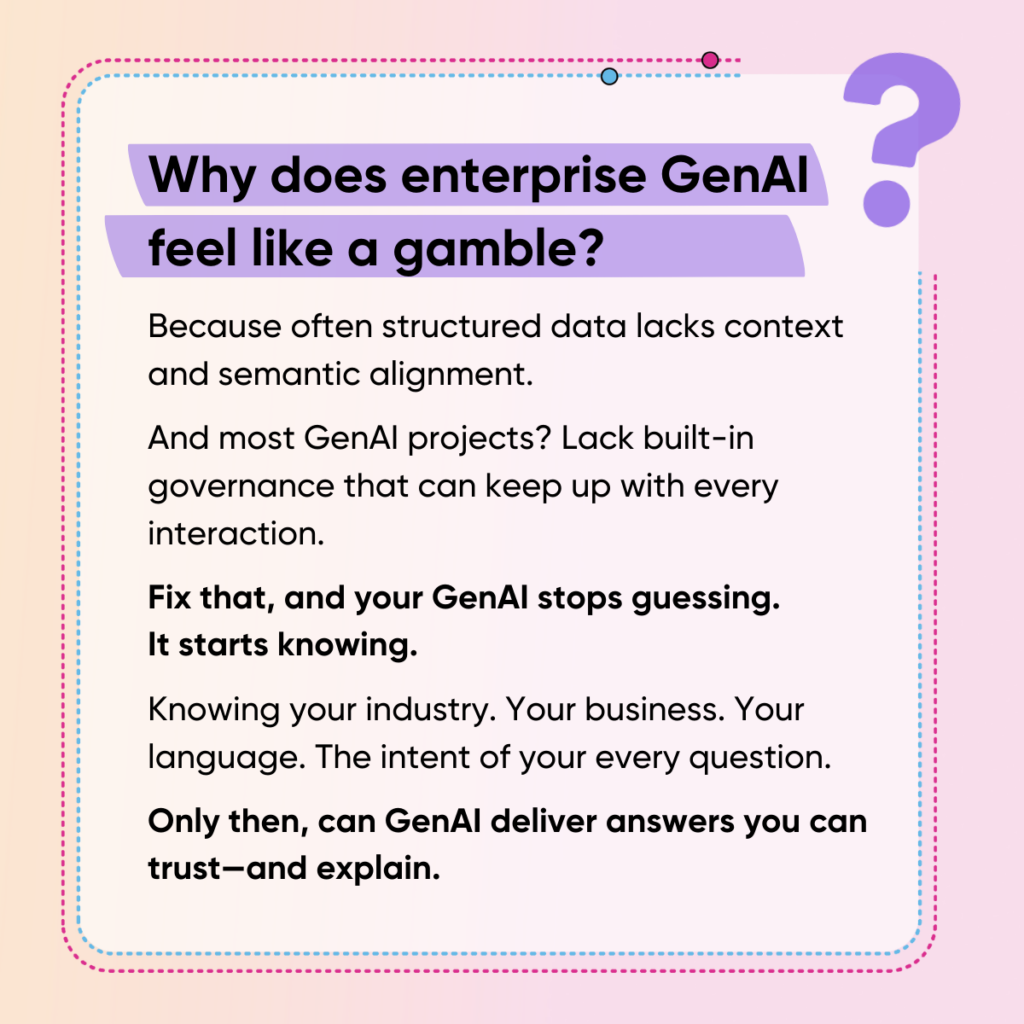
10 Resources to Make Your Data AI-Ready in 2025
What’s the key to turning your GenAI dreams into real-world results?
It’s your data. With the right approach, it becomes the fuel GenAI needs to deliver sharp, governed answers that impress everyone from the boardroom to the break room.
Here are the top 10 resources we shared in 2024 to help your GenAI aspirations become 2025 wins. Think of these as your go-to toolkit for getting your data in shape: aligned, context-rich, and ready to work smarter.
From simplifying governance to breaking down silos, these resources are here to help your enterprise GenAI become accurate, explainable, and effortless to trust.
What’s the True TCO of LLMs?
GenAI needs more than just solid data management. It requires a whole new level of risk control. With traditional analytics, a small error might fly under the radar. But with GenAI? Every mistake is magnified, especially when non-technical users have self-service access to insights.
That’s why managing the Total Cost of Ownership (TCO) of LLMs isn’t just a line item in your budget. Clear definitions, tight access controls, and robust governance are non-negotiables for sustainable GenAI success.
Consider the following scenario: users interpret data differently because definitions aren’t aligned. Suddenly, you’re dealing with inconsistent results, and trust in GenAI takes a serious hit. Or think about sensitive data slipping into the wrong hands because access rights weren’t thoroughly managed. The impact on cost and risk multiplies quickly.
Building a controlled, well-defined environment keeps your GenAI both cost-effective and reliable, laying the groundwork for trustworthy, governed responses that can guide your business decisions.
But real GenAI implementation success goes beyond governance alone. It’s about creating a space where humans and machines collaborate seamlessly. When done right, this approach can:
- Protect your data
- Support efficient AI usage, and
- Nurture a data-driven culture that maximizes GenAI’s value across the organization.
For a closer look at the TCO factors that often go unnoticed (and how to minimize costs), check out the full blog post.

How to Keep Up with AI Governance
The old ways of governance don’t work for GenAI. Static rules and manual processes weren’t designed for systems that make decisions on the fly, pulling data from everywhere. Worse, most GenAI implementations lack governance altogether, leaving gaps that lead to risky, untrustworthy outputs.
With the right approach, your GenAI stays governed, consistent, and ready to help you make the best decisions. Here’s how you stay in control:
- Automate the heavy lifting such as monitoring, documentation, and compliance checks to keep data secure and trustworthy.
- Break down silos with a unified governance framework that connects teams and standardizes data for reliable AI insights.
- And don’t forget transparency: build trust by baking governance and explainability into every GenAI interaction. How GenAI reaches decisions shouldn’t be a black box.
Learn how to make enterprise GenAI your ally (and not a risk) in this blog.
Is RAG Truly the Best Choice for Your Organization?
Many companies use RAG (Retrieval-Augmented Generation) to customize LLMs and augment context for GenAI because it gets the job done.
But there’s a catch. RAG is labor-intensive, time-consuming, and imperfect. It’s burdened with:
- High costs from additional API calls (devouring up to 80% of your token budget)
- Complex manual setups eat into productivity, putting even more strain on data teams
- Constant maintenance to guarantee accurate results—relying on costly specialized skills with no end in sight.
And what about the results? Are they stable and explainable? Nope. On both counts.
Using RAG leaves plenty of room for mistakes and can lead to ongoing headaches that slow down your progress. There’s a smart, cost-effective way to deploy your LLM and make sure it delivers accurate, hallucination-free responses (read more about it in this blog).
To make things easier, we’ve put together a comparison between RAG and Generative Semantic Fabric (GSF) (it also includes a detailed look at each architecture). You can grab your copy here and decide which one’s better for your business needs.
Cure Your Data & GenAI Woes with Augmented Governance
Governance has a branding problem. People hear it and think: rules, restrictions, red tape. But done right, it’s none of those things.
It’s freedom. Freedom to act with confidence. Freedom to trust your tools. Freedom to stop second-guessing every decision. Teams thrive when they trust their data. Decisions get made faster. Silos crumble. Arguments over “whose data is right” vanish.
Augmented governance creates a shared language, a single source of truth that everyone—from data pros to business users—can rally around. Here’s how it simplifies everything:
- Centralized clarity: Automatically creates a glossary with clear, mapped relationships—one trusted source for all.
- Effortless classification: Connects siloed data without moving it, auto-classifying by content, sensitivity, and compliance needs.
- Real-time safeguards: Proactive guardrails catch risks instantly and keep every GenAI response accurate.
- Streamlined reporting: Auto-tracks changes and keeps compliance reports audit-ready.
- Shared responsibility: AI-driven tools assign data ownership across teams for fast, informed decisions.
A data (and GenAI) foundation you can trust is easier to build than you think. And you can start by reading this blog.
Here are the 7 “sins of data management” that you should avoid if you want your GenAI model to work for you and not the other way around.
How Can You Prevent AI Hallucinations?
88%. That’s the rate of GenAI hallucinations in legal queries alone. Now, imagine what that means for finance, healthcare, or pharma. One bad output and it’s not just your data team sweating. Your reputation, compliance, and bottom line could be on the line.
It’s no wonder McKinsey found 63% of execs cite inaccurate outputs as GenAI’s biggest risk. But why does it happen?
- Messy data: Silos and conflicting sources confuse the model.
- Generic training data: Context matters, and your industry-specific language is missing.
- No governance: Hallucinations slip through when there’s no safety net.
Even manual workarounds like RAG are no magic fix. They drain resources, rack up token costs, and still leave you guessing which answer to trust. The good news is AI hallucinations are preventable.
Through tools like automated context and reasoning, and augmented governance, you can take your GenAI from confident “half-truths” to business-ready brilliance. And this means governed, accurate, and hallucination-free outputs. Every time.
Want to know how? Read all about it in the blog.
Your Blueprint to AI-Ready Data
Here are three Gartner stats every data leader should pay attention to:
- By 2026, 60% of AI projects will fail without AI-ready data.
- 30% of GenAI projects will stall after PoC due to poor data.
- GenAI could slash data costs by 20% annually and unlock 4x more use cases.
AI-ready data isn’t a destination. It’s a road you’ll travel again and again. So, where should you start?
First, focus. AI-ready data isn’t about perfection. It’s about purpose. Your data needs context, flexibility, and constant refinement. Start by asking: Is your data fit for the job?
Next, show the value. Build your case to get executive buy-in. Tie it to real wins: faster insights, better decisions, measurable ROI. Executives don’t need buzzwords. They need proof.
Then, get to work. Data fabric. Active metadata. Knowledge graphs. Tools that bring meaning and context to your data and make it ready for GenAI’s demands.
Finally, govern and adapt. GenAI will change your systems, your teams, and your workflows. Plan for it. Automate what you can. Build guardrails that move with your data at scale. Train your people to think faster and smarter.
We map out each step and what actions you should take in our detailed ‘Data Leader’s Blueprint to AI-Ready Data’ blog. Check it out here.
How Teva Sped Up Data Product Release 5x
Teva Digital Health’s smart inhalers are helping advance asthma care by tracking real-time medication usage. But mountains of data with no context and semantic meaning? That’s just noise.
The pharmaceutics giant needed a way to govern and use its massive amount of data for better patient outcomes without spiraling costs.
By partnering with illumex, Teva built a powerful data framework to manage, categorize, and govern their data. This allowed them to automate processes and scale with ease. They achieved:
- 90% reduction in manual data handling and documentation
- 5x faster data product releases to keep pace with patients’ needs
- Smooth compliance across departments
- Fully governed, AI-ready data foundation—without a long, heavy setup
Grab a copy of the full Teva case study to learn how they did it.
How to Automate Context and Reasoning for GenAI
Over 65% of companies now use GenAI regularly, according to McKinsey. And while hopes are high for GenAI to bring major change, so far, most projects flop. The reason is usually a lack of user trust.
In fact, nearly 1 in 4 companies say GenAI’s inaccuracy has already caused them trouble. So, if you’re frustrated with GenAI answers that sound confident but don’t actually add up, you’re not alone.
It’s not you (or your prompts). It’s not even the model. It’s your data that is to blame. The truth is, your GenAI is only as good as the context it gets. And that’s where Generative Semantic Fabric (GSF) steps in.
GSF automatically builds context and reasoning for your GenAI, so every response aligns with your business logic and goals.
It’s pre-trained on industry-specific knowledge (not some random internet noise), retrains on your unique metadata, and scales without breaking a sweat. You get accurate, governed, and trustworthy answers. Every single time.
Read more in this blog, to learn how GSF makes your enterprise GenAI into a decision-making partner that is fluent in your business language.
How to Make Structured Data Work for You
When it comes to AI-readiness, structured data is your secret weapon. It builds the foundation for data-based decisions. Yet, unlike its freeform counterpart, structured data lacks the built-in business context, logic, and semantics. And without the right prep work, it can derail GenAI projects.
In other words, structured data is your GenAI’s MVP. But only if it’s ready. Here’s how to make it unstoppable:
- Create A Single Source of Truth (without moving data around): Unify your data across silos, departments, and tools. Automatically reconcile and build semantic meaning and business context into your data. Turn those rows and columns into rich, trustworthy data your GenAI can easily understand.
- Automate Your Metadata (and save sanity): Ditch manual fixes. Use active metadata to automate mapping, labeling, and updates to keep your data sharp, accurate, and always ready for GenAI and analytics.
- Lock Down Governance (and boost trust): Use augmented governance to take the heavy lifting off your governance workflows. Auto-tag your sensitive data, automate documentation, auto-track data lineage, and make sure each GenAI interaction is governed via metadata-activated guardrails (that grow right along your data).
Learn more in this blog.
How Data Migration Was Transformed with GenAI
Migrating enterprise systems can feel like untangling a ball of yarn, especially when dealing with legacy on-prem systems like SAP ECC. For one leading retail company, migrating SAP S/4 HANA to the cloud seemed like a mission impossible.
Their data was incomplete. Their processes were undocumented. They had 115,000 tables and 1.5 million columns of data, all labeled in cryptic code with no clear context or meaning. And the manual effort required to map and label everything properly? A staggering 17,000 FTE hours, or 700 workdays.
Here’s what they achieved with illumex:
- 90% less manual effort: Two years’ work shrank to a week.
- Context on demand: Automatically enriched SAP tables made sense of cryptic data.
- Semantic search that delivers: Lightning-fast answers, even with immense data.
- Cost savings baked in: Migrated only the essentials to cut cloud costs.
- Data clarity for all: Complex insights became accessible to every stakeholder.
Read the interview with the retail company’s Head of Data or grab a copy of the case study here to learn more.
Just for fun: Check out your data’s 2024 highlights 😉
Ready to make your data AI-ready in 2025?
There you have it. The tools and insights to steer your data strategy toward GenAI success in 2025.
Remember, the road to AI-readiness is a journey, not a destination. It’s about simplifying, automating, augmenting, and evolving your approach to data management and governance.
Here’s to 2025: the year your data truly works for you!




